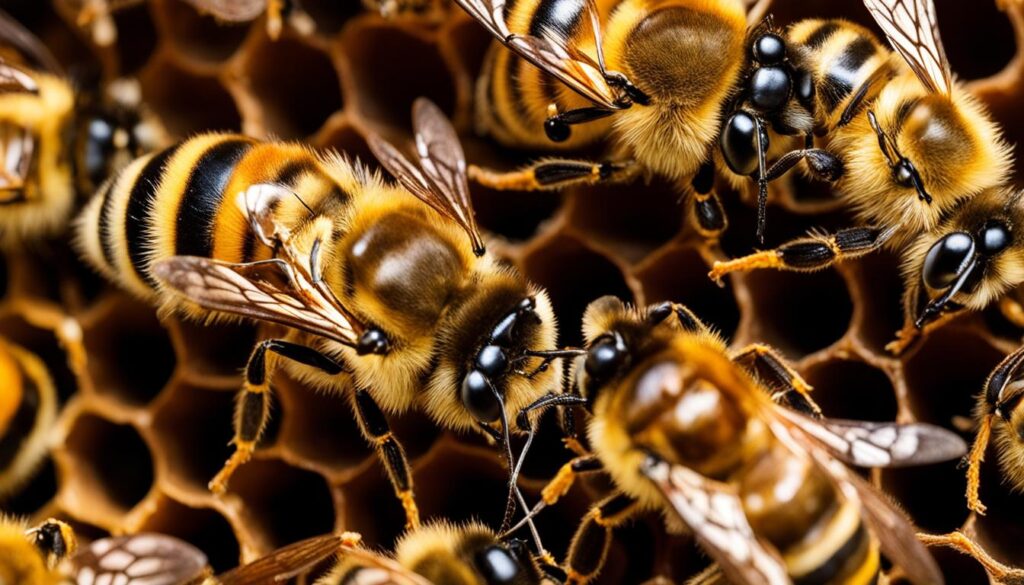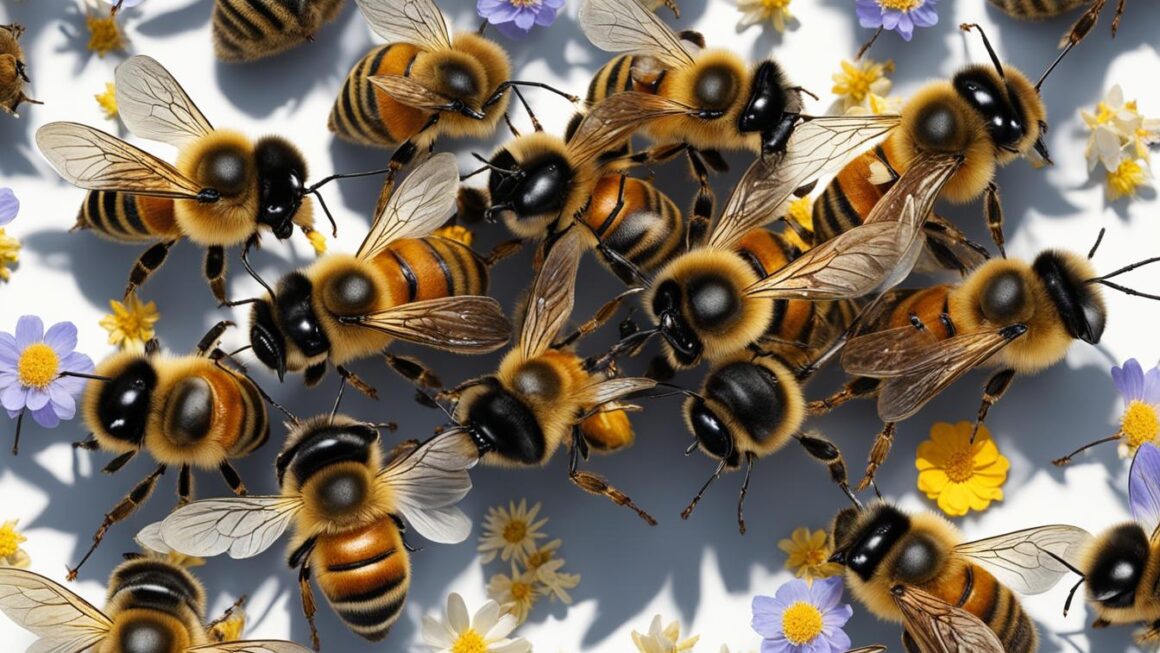Welcome to the captivating world of queen bees! Have you ever wondered why these regal insects hold such importance in a bee hive? In this article, we will delve into the intriguing reasons behind the existence of queen bees and explore their vital role in maintaining the delicate balance of a bee colony. From their remarkable abilities to their essential responsibilities, queen bees are truly fascinating creatures.
Key Takeaways:
- The queen bee is the only female bee to undergo sexual maturity and is responsible for bearing offspring and reproducing the colony.
- Queen bees possess unique skills in maintaining the hive, constructing structures, fighting adversaries, and preserving essential supplies.
- They are highly influential as empire-builders and matriarch bees in the insect kingdom.
- Queen bees play a crucial role in maintaining a healthy and balanced hierarchy within the hive, providing guidance and support for growth and development.
- The lifespan of a queen bee is influenced by various factors, including environmental conditions.
The Mastery of Queen Bees in Colony Formation
Queen bees are truly remarkable in their ability to establish and build successful bee colonies. Their mastery in colony formation is unparalleled in the insect world. Through their remarkable skills and behaviors, queen bees ensure the growth and survival of the hive.
One of the key aspects of queen bee biology is their role in foraging for optimal food sources. They have a keen ability to locate and gather pollen and nectar, ensuring a steady supply of resources for the colony. This allows the colony to thrive and flourish.
“Queen bees are the architects of the hive, directing worker bees in establishing a successful hive environment and protocols.” – Beekeeping expert
In addition to foraging, queen bees also practice colony division to expand the bee population. This process, known as swarming, involves the queen bees leaving the hive with a portion of the worker bees to establish a new colony. By doing so, queen bees ensure the continuation of the bee population and the spread of their genetic lineage.
The skills and abilities of queen bees in colony formation and reproduction are truly awe-inspiring. They hold a vital role in the intricate dynamics of the hive, contributing to the overall success and survival of the bee colony.
A Look into the Role of Queen Bees
Queen bees are the backbone of a bee hive, responsible for maintaining order and ensuring the survival of the colony. Their role is multifaceted and crucial to the overall functioning and success of the hive. Let’s delve into the responsibilities and importance of queen bees in more detail.
The Responsibilities of Queen Bees
The primary responsibility of a queen bee is to lay eggs, ensuring the continuous growth and replenishment of the hive. In fact, a queen bee can lay up to 2,000 eggs each day. This constant supply of new members is essential for maintaining and expanding the population of the colony.
Queen bees also release pheromones, which serve as a chemical language that communicates with worker bees. These pheromones help regulate the behavior and activity levels of the workers, ensuring they perform their assigned tasks efficiently and effectively.
“The queen bee is like the CEO of the hive, providing guidance and direction to her workforce. She ensures the smooth functioning of the hive and fosters a harmonious environment for all the bees.”
In addition to these responsibilities, queen bees are also involved in the selection and elimination of drone bees. Drones are male bees whose sole purpose is to mate with the queen. Once the mating is complete, the queen will either keep or eliminate the drones based on the needs of the hive.
The Importance of Queen Bees
The role of queen bees cannot be overstated. They are the heart and soul of the hive, providing stability, structure, and continuity. Without a queen, the hive would cease to exist as the workers would lack direction and purpose.
Queen bees are essential for maintaining a balanced hierarchy within the colony. They ensure that tasks are distributed appropriately among the worker bees, preventing any one bee from becoming overwhelmed or neglected. This organized structure allows the hive to function smoothly and efficiently.
In conclusion, queen bees play a critical role in the survival and prosperity of a bee colony. Their responsibilities include laying eggs, releasing pheromones, and maintaining the overall harmony of the hive. The importance of queen bees cannot be underestimated, as they are essential for the growth and well-being of the entire bee community.
An Overview of Queen Bee Lifespan
Queen bees have a lifespan of four to five years, while worker bees have an average life expectancy of just six to eight weeks. The stark contrast in their lifespans highlights the crucial role that queen bees play in the longevity and success of a bee colony. These remarkable insects go through various stages in their lifespan, each with its own unique significance.
Queen bees begin their lives as eggs laid by the previous queen. They undergo a process of development, emerging as adult bees capable of reproduction. Once mature, queen bees embark on their vital task of mating with drones to ensure the continuation of the colony. During mating flights, a queen bee may mate with numerous drones, storing their sperm in her body for future use.
Throughout their lifespan, queen bees are responsible for laying eggs, ensuring the colony’s growth and survival. They can lay thousands of eggs each day, ensuring a constant influx of new workers and drones to support the hive’s functions. As queen bees age, their egg production gradually decreases, and they typically retire from laying eggs after a few years.
| Age | Queen Bee Activity |
|---|---|
| 0-5 days | Mating flights and storing sperm |
| 5-15 days | Egg-laying |
| 15 days onward | Retirement from egg-laying |
Factors such as environmental conditions, the health of the hive, and the availability of resources can affect the lifespan of queen bees. A healthy and well-maintained hive provides a conducive environment for the queen bee to thrive, potentially extending her lifespan. On the other hand, stressful conditions or diseases can shorten a queen bee’s lifespan.
Understanding the lifespan of queen bees provides valuable insights into the dynamics of bee colonies and their sustainability. It is a testament to the remarkable abilities and importance of these matriarchal insects in the intricate balance of the hive.
A Fascinating Dive into the World of Queen Bees
Queen bees lead an intriguing lifestyle within the intricate dynamics of a bee hive. From their birth to their responsibilities as matriarchal figures, they play a vital role in the growth and maintenance of the colony.
Upon hatching, queen bees go through a process of growth and development, maturing into powerful and authoritative leaders. They have the remarkable ability to control every bee in the hive and are solely responsible for reproduction. Through their egg-laying skills, queen bees ensure the continuation and expansion of the colony.
The hive itself is a well-structured and organized environment, divided into distinct groups: workers, drones, and the queen bee. Each group holds specific roles and responsibilities. Workers are responsible for gathering resources, while drones serve as mates for the queen. The queen bee, with her authority and leadership, guides the hive towards prosperity and success.
To provide a visual representation of the intricate world of queen bees, let’s take a look at the following table which highlights the key aspects of their lifestyle and lifecycle:
| Stage | Description |
|---|---|
| Birth | Queen bees are born every three to five years and go through a process of growth and development. |
| Authority | Queen bees have the authority to control any bee in the hive and are responsible for reproduction. |
| Hive Structure | The hive is divided into workers, drones, and the queen bee, each with specific roles and responsibilities. |
| Growth and Maintenance | The queen bee is essential for the growth and maintenance of the hive, providing guidance and structure. |
Examining the Interaction of Queen Bees with Worker Bees
Queen bees and worker bees have a complex and interdependent relationship within the hive. The queen bee is the reproductive powerhouse, responsible for laying eggs and ensuring the survival of the colony. Worker bees, on the other hand, perform various essential tasks, such as building and maintaining the hive, gathering food, and caring for the queen’s offspring. This dynamic interaction between the queen and the workers is vital for the overall success and productivity of the bee colony.
The queen bee’s role in the hive is to lay eggs, and she is solely responsible for the continuation of the colony. Once the queen has mated, she can store the sperm for a long period and selectively fertilize the eggs she lays. This ability enables her to control the genetic diversity within the colony. The workers, on the other hand, provide the necessary resources for the queen’s egg-laying, including food and a clean environment. They feed and care for the queen, ensuring her well-being is maintained.
In return, the queen bee produces pheromones that regulate the behavior and development of the worker bees. These chemical signals influence the workers’ tasks and prevent them from developing reproductive capabilities. The presence of the queen’s pheromones maintains the unity and harmony of the hive, preventing conflicts and ensuring the efficient functioning of the colony.
| Queen Bees | Worker Bees |
|---|---|
| The sole reproducers of the colony | Perform various essential tasks |
| Selectively fertilize eggs | Provide necessary resources for the queen |
| Produce pheromones that regulate behavior | Carry out tasks influenced by the queen’s pheromones |
The relationship between queen bees and worker bees is one of mutual dependence and cooperation. It is through this interaction that the colony thrives and maintains its delicate balance. The queen’s leadership and reproductive prowess, combined with the workers’ dedication and support, create a harmonious society that ensures the survival and success of the bee colony.

Unveiling the Fascinating World of Queen Bees
The lifestyle and lifecycle of queen bees are a mesmerizing glimpse into the mysterious world of these remarkable insects. Queen bees, as the matriarchs of the hive, hold immense power and responsibility, driving the growth and maintenance of their colonies. They embody strength, grace, and strategic prowess, showcasing their mastery in various aspects of hive life.
From the moment a queen bee hatches, she embarks on a journey filled with unique stages. As she matures, the queen bee’s primary focus shifts toward mating and reproduction. Guided by instinct and pheromones, she embarks on nuptial flights, seeking drones from neighboring colonies to ensure genetic diversity within her hive. Once successfully mated, the queen bee returns to the hive, ready to fulfill her critical role in sustaining the colony.
The queen bee’s presence dictates the hive’s harmony and productivity. She controls the process of reproduction, laying thousands of eggs throughout her lifespan. These eggs hatch into worker bees and drones, each with distinct duties within the social structure. The queen bee’s regal authority extends beyond reproduction; she oversees hive organization, maintaining order, and optimizing resource management. Her influence permeates every aspect of hive life, enabling the colony to thrive.
| Queen Bee Lifecycle | Description |
|---|---|
| Hatching | The queen bee emerges from her pupal stage, ready to take on her leadership role. |
| Mating | The queen bee embarks on nuptial flights to mate with drones, ensuring genetic diversity within the colony. |
| Egg-laying | Throughout her lifespan, the queen bee lays thousands of eggs, ensuring the survival and growth of the hive. |
| Leadership | The queen bee governs the hive with authority, overseeing hive organization and resource management. |
“The queen bee’s journey from hatching to leadership is a marvel of nature’s brilliance. Her ability to guide and sustain the hive is truly awe-inspiring.” – Beekeeping expert
The remarkable lifestyle and lifecycle of queen bees offer a profound appreciation for their vital role in the insect kingdom. Their leadership, reproduction, and hive maintenance drive the growth, balance, and success of the colony. Queen bees embody the embodiment of strength, unity, and resilience, ensuring the survival of their hive and perpetuating the extraordinary world of bees.
Conclusion
Queen bees are an integral part of a thriving bee community. Their unique role as matriarchs brings balance, structure, and reproductive success to the hive. With their ability to lay eggs, construct hive structures, and preserve vital resources, queen bees ensure the growth and survival of the colony.
Through their exceptional skills in colony formation, queen bees establish and build successful bee colonies. They forage for optimal food sources, practice colony division to expand the bee population, and direct worker bees in maintaining the hive environment.
The leadership and authority of queen bees are central to maintaining a healthy and functioning hive. They provide guidance, mentorship, and support for the growth and development of their team members. Queen bees play a crucial role in maintaining equilibrium and structure within the hive, making them truly remarkable and essential creatures in the natural world.
FAQ
Why is there a queen bee?
Queen bees play a unique and powerful role in maintaining the delicate equilibrium of a bee hive.
What is the importance of a queen bee?
Queen bees are responsible for bearing offspring and reproducing the colony. They also maintain the hive, construct hive structures, fight off adversaries, and preserve pollen and nectar supplies.
What are the responsibilities of a queen bee?
Queen bees are empire-builders and matriarch bees. They establish and build successful bee colonies, forage for optimal food sources, practice colony division, and direct worker bees in controlling the hive environment and establishing protocols.
What is the lifespan of a queen bee?
Queen bees have a lifespan of four to five years, while worker bees have an average life expectancy of just six to eight weeks.
How does a queen bee interact with worker bees?
Queen bees are the sole reproducers of the colony, while workers perform other necessary functions. Workers rely on the queen for successful reproduction, while the queen relies on workers for gathering resources. Both queen bees and worker bees are interdependent for the survival of the colony.
What is the significance of queen bees?
Queen bees bring guidance, unity, and structure to the hive. Their leadership and authority are essential for maintaining a healthy and balanced hierarchy in the hive.
What is the lifestyle and lifecycle of a queen bee?
Queen bees go through different stages in their lifespan, including egg-laying, mating, and laying eggs for drones. Their lifestyle involves establishing and maintaining the hive, controlling the reproduction process, and ensuring the growth and stability of the colony.
Why are queen bees fascinating?
Queen bees possess remarkable behaviors and abilities that make them a truly remarkable and essential part of the natural world. They orchestrate the buzzing culture of their colonies, establish and build successful hives, and maintain equilibrium and structure within the hive.




